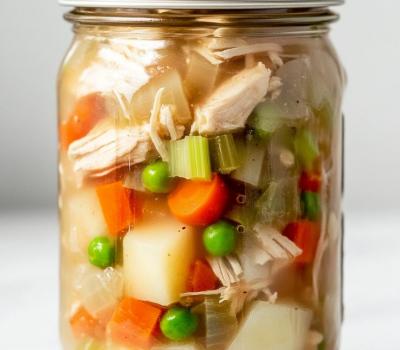All tags
5 star recipes
A
air fry
alcohol beverages
Beverages
BREADS
Breakfast
cakes
Candy
Casseroles
charcuterie boards
Chicken
chili
Chinese
Chowder
Christmas
coffee cakes
Conversion Chart
cookies
dale.
DESSERTS
DIPS
easter
fish
Freezer Meals
Friends
Halloween
herbs/spices
jan's canning
jan's ice cream
meat
Mexican
MISC
Muffins
new years
pasta
Pastry
Pies
polish
Potatoes
potpourri
pressure canner
QUICK BREADS
Rice
Salad Dressings
SALADS
sandwich spreads
Sandwiches
Seafood
Skillet
SNACKS
Soup
st. patrick
Stews
summer
t
Thanksgiving
Vegetables

Canning Chicken Soup
Pressure cooking and canning chicken soup is a great way to ensure you can enjoy the soup year round.
Ingredients
1 chicken, about 5 lbs5–6 carrots
3 yellow onions
1 head of celery
3 lbs potatoes
2 cups peas (optional)
1–2 heads of garlic
1 Tablespoon of rosemary
2 Tablespoons Italian seasoning
1 Tablespoon black pepper
8 teaspoons salt
Equipment needed:
Canning jars
Rings and lids
Pressure canner
Instructions
Place chicken in a large pot and cover with 4 quarts of waterHeat over medium-high heat and bring to a boil
Reduce heat, and let simmer until cooked through, about an hour
Remove from heat and remove chicken to a separate pan or bowl to cool
While chicken is cooking, prepare vegetables by peeling and dicing carrots, onions, and potatoes, dicing celery, and peeling and mincing garlic
Add prepared vegetables to a large pot or bowl, and top with rosemary, Italian seaosning, and black pepper
Strain particles out of broth with a sieve if necessary, and add to vegetables
When chicken is cooled enough to handle, debone, and chop, discarding bones and skin, or reserving to make bone broth
Add chicken to vegetables and broth, and stir
Prepare Canning jars. This recipe should be enough for 8 quarts, or “7 quarts and dinner” since seven quarts is the quantity most pressure canners can hold
Fill canning jars with soup, leaving 1/2-1 inch of headspace
Top each quart jar with 1 teaspoon salt, or pint jars with 1/2 teaspoon of salt
Wipe rims of jars, and screw down lids and bands
Place into a prepared pressure canner, and lock down lid
Heat canner over medium-high heat until canner vents steam steadily
Set timer, and let steam vent for 10 minutes
Close steam valve, and bring pressure to 10 PSI, or the necessary equivalent for your elevation (see conversion chart here)
Process quart jars for 90 minutes, or pint jars for 65 minutes
Remove from heat after processing time is finished, and let canner return to zero pressure naturally
At this point, you may open canner if needed, and transfer jars to a towel-lined surface to finish cooling, being sure to cover jars with a second towel to protect hot jars from drafts. Do this CAREFULLY, as jars are extremely hot, and they could possibly break or even explode, causing burns. Keep in mind that it’s best to let jars cool as much as possible before doing this to minimize this risk.
After 24 hours, test jars for seal, wash if needed, and store in a cool place, out of direct light.